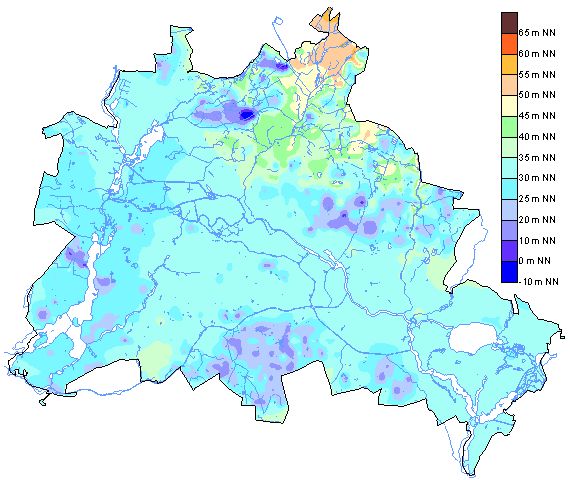In the unconfined areas, the free measured groundwater pressure area is represented; in the confined areas, it is the lower level of the obstructing covering layers. This corresponds exactly to the actual conditions in nature. The groundwater surface in a bore or an excavation is tapped exactly at a certain altitude above sea-level, as can be seen from the Fig. 6. The representation and interpretation of this intermediate result is moreover an important plausibility check toward the determination of the groundwater depth, since by the integration with the altitude model incorporates new, independent information into the model. Any uncertainties in this intersection result may then result from implausibilities in one or the other of the two independent information sources.
By the inclusion of the lower edges of the obstructing surface layers, the areas in which the (confined) groundwater surface is located under a thick marl covering at a depth of roughly 0 m above sea-level are shown very clearly in Fig. 5, with the dark blue colors.
On the Barnim Plateau, the deep areas are located particularly in the northeast (Rosenthal) and along the southern edge of the ground moraine plate (Lichtenberg). The southern part of the Teltow Plateau (Marienfelde, Buckow) is characterized by maximum depth of groundwater surface of about 15 meters above sea-level. The locations of greatest altitude of groundwater surface, about 50 m above sea-level, are found in the northeastern, unconfined area of the Panke valley (Buch). In the glacial spillway, there is a continuous drop of the groundwater surface in the direction of flow of the two main receiving streams, the Havel and Spree, in an east-to-west and a north-to-south direction, respectively. This supports the posited hydraulic contact between the surface and groundwater.
Subsequently, a difference model was calculated from the Model of the Upper Surface of Groundwater and the Terrain Elevation Model. The width of the grid was 100 m. The depths to groundwater were broken down into seven depth classifications portrayed, as a map of different levels of groundwater. In order to differentiate depths to groundwater in the range of up to 4 m, especially in areas important for vegetation, an irregular division of classification was chosen.
For smaller areas it is possible to obtain more exact results with the digitalized data available, using smaller grid widths to interpolate the data, provided that the density of the Terrain Elevations Model permits this. Value limits used for classification of depths to groundwater can also be chosen arbitrarily, and are also available with discrete information in the calculated data base.
The exactness of the data collected for the Groundwater Depth Model is directly dependent on the quality of the Terrain Elevations Model. Therefore, any miscalculations in the Terrain Elevations Model also apply to the Groundwater Depth Model.
The following points should be considered, to avoid false interpretations:
- Narrow strips at the edge of surface waters, which in some cases are connected to groundwater, cannot be portrayed in the scale used here, 1:50,000.
- Because of the state of the data, the Terrain Elevations Model will show some inaccuracies. This relates on the one hand to areas in the outlying districts (forests and agricultural areas) with not enough points of elevation and on the other hand to areas that were not yet developed at the time when the measurements were taken. Because of landfilling during construction projects, some of the depressions shown on the map, with a low depth to groundwater, no longer exist.
- In areas where groundwater is located under thick relatively impermeable, obstructive boulder marl layers (and is then usually also confined), the depths to groundwater can be assumed to be more than 10 m, and often even more than 20 m. The lower edge of the groundwater-obstructing layer is assumed to be the upper surface of the groundwater. Sandy interstratifications in these boulder marl layers, within which near-surface confined groundwater can also appear, are narrowly limited spatially, and their sites can hardly be localized; they have therefore not been taken into account in the determination of depth to groundwater.
- The upper surface of the groundwater is subject to strong fluctuations in areas near wells, depending upon withdrawal amounts. For this reason, locally higher depths to groundwater can occur here. The sizes of these areas cannot be portrayed in the scales used here, either.
- It is to be noted that not all wetland areas potentially valuable for the protection of biotopes and species can be gleaned from the Map of Depth to Groundwater (depth to groundwater less than 1.0 m). This includes areas which, e.g., have no connection to groundwater and are watered by dammed water or periodic natural flooding (such as the Tiefwerder Meadows).

